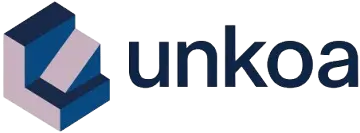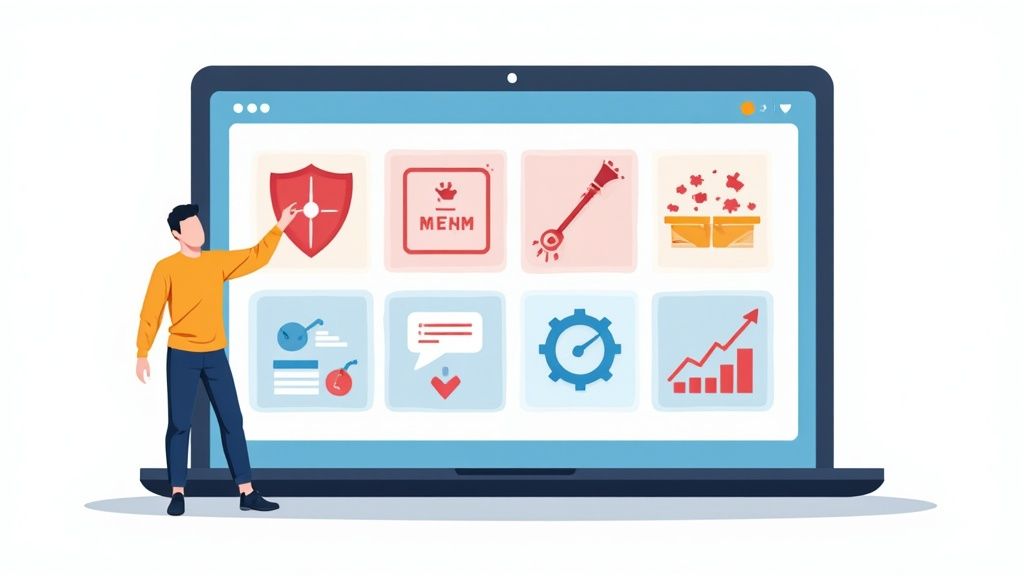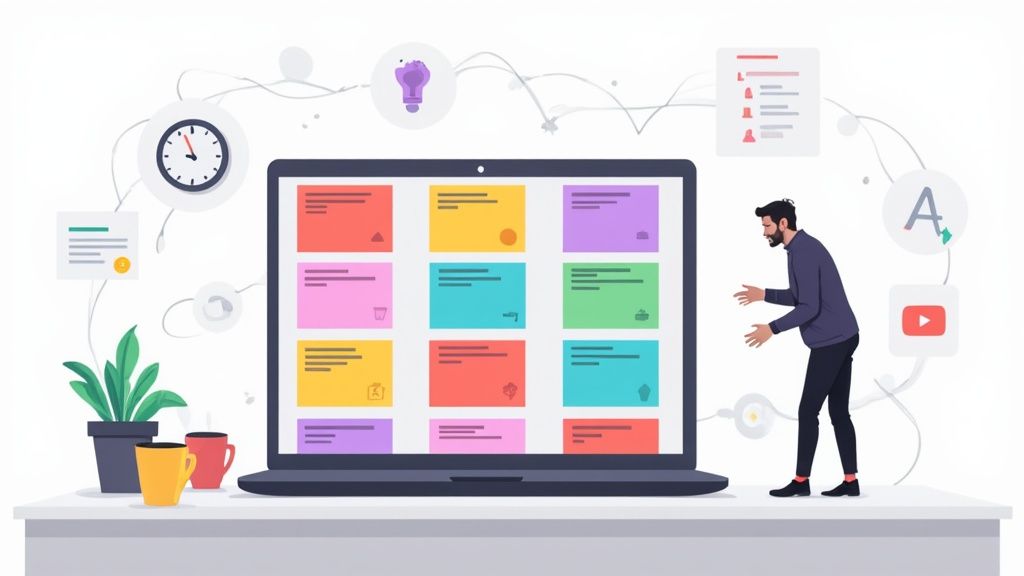Proven Ways How to Get Consulting Clients

Getting consulting clients all starts with nailing the foundation: defining a profitable niche, sketching out a detailed picture of your ideal client, and crafting a value proposition they simply can’t ignore.
Getting this groundwork right is the single most important step you can take. It’s what ensures every ounce of marketing effort you put in actually hits its mark.
Building Your Client Attraction Foundation
Before you even think about sending that first cold email or making a call, you need to lay the groundwork. The best consultants I know are masters of this. It’s not about writing some generic business plan; it's about making sharp, strategic decisions that pull the right clients in and actively push the wrong ones away.
Without this clarity, all your marketing will feel like shouting into a void. You’ll just be making noise.
The whole point is to shift from being a generalist who can help anyone to a specialist who is the only logical choice for a specific type of client facing a specific, expensive problem. That focus is your biggest weapon.
Define Your Profitable Niche
A niche isn't just an industry you feel like working in. It's the sweet spot where your expertise, real market demand, and profitability all collide. Trying to be everything to everyone is a recipe for burnout and mediocre rates. Don't do it. Instead, become the absolute go-to expert for a very specific audience.
When you specialize, a few things happen:
- You can charge premium prices. Experts who solve painful, high-value problems will always command higher fees than generalists.
- Marketing gets way easier. When you know exactly who you're talking to, writing content and outreach messages is a breeze.
- You build authority faster. It's much easier to become known as the top "Shopify conversion rate consultant for DTC apparel brands" than just another "marketing consultant."
Picking the right specialization is a make-or-break decision. You can find a ton of detail on this in our guide on how to choose a profitable niche for your freelance business. This clarity is the launchpad for everything that follows.
Create Your Ideal Client Profile
Once you’ve got your niche locked down, it's time to get incredibly specific about the person you want to work with. An Ideal Client Profile (ICP) is a detailed description of the company—and the decision-maker inside it—that you are perfectly built to serve. This isn't just about demographics; it's about their daily frustrations, their career goals, and the problems that keep them up at night.
An effective ICP is a filter. It tells you who to pursue relentlessly and, just as importantly, who to politely decline. This focus saves you countless hours chasing unqualified leads.
Your ICP should be concrete. Think company size, industry, annual revenue, and the exact job title of the person who would sign your check (e.g., VP of Marketing, Head of Operations).
Building out a detailed ICP is non-negotiable. It guides every decision you make in your marketing and sales efforts. This checklist will help you get started on defining exactly who you're targeting.
Ideal Client Profile (ICP) Development Checklist
A checklist to help consultants define their target audience with precision, ensuring marketing efforts are focused and effective.
| Attribute | Example | Your Definition |
|---|---|---|
| Industry/Vertical | B2B SaaS, E-commerce (Apparel) | |
| Company Size | 50-200 employees | |
| Annual Revenue | $10M - $50M ARR | |
| Geography | North America, UK | |
| Key Decision-Maker Title | VP of Marketing, Director of Growth | |
| Primary Pain Point | Stagnant lead growth, high CAC | |
| Business Goals | Double demo requests in 6 months | |
| Technology Stack | Uses HubSpot, Salesforce, Google Analytics | |
| Watering Holes | Follows SaaS-focused podcasts, active on LinkedIn |
Once you've filled this out, you'll have a crystal-clear picture of the person you need to reach. Every piece of content, every email, and every ad should speak directly to this profile.
Craft a Compelling Value Proposition
Now, what do you say to this ideal client? Your value proposition is a short, punchy statement that explains the tangible results they get from working with you. It needs to immediately answer their unspoken question: "What's in it for me?"
A weak proposition is all about what you do: "I offer SEO consulting services." A strong one is about the outcome: "I help B2B SaaS companies double their inbound demo requests in six months through targeted SEO." The difference is everything when it comes to grabbing someone's attention.
This statement becomes the headline on your website, the banner on your LinkedIn profile, and the core message in all your outreach.
Establish a Professional Online Presence
Your online presence is your digital storefront. It needs to look the part and be built to turn visitors into leads.
First, get a clean, modern website up. You can use a powerful platform like Webflow or even a simple landing page builder like Leadpages to get started. Your site must clearly state your value proposition and have an obvious call-to-action, like "Book a Discovery Call."
At the same time, dial in your LinkedIn profile. It's not a resume—it’s a sales page. Your headline and "About" section should speak directly to your ICP's problems and position you as the person with the solution. This foundational work makes sure that when the right people find you, they're already sold on your expertise.
Mastering Outbound for a Predictable Pipeline
Alright, you've got your foundation sorted. Now it's time to stop waiting for clients to find you and start proactively filling your pipeline.
While inbound marketing is great for building long-term authority, a smart outbound process is how you generate predictable opportunities right now. This isn't about blasting out generic spam; it's a methodical way to reach the right people, with the right message, at the right time.
This proactive approach is what separates consultants who are constantly feast-or-famine from those with a reliable engine for growth. The goal is a repeatable system you can fire up whenever you need to start new conversations with your ideal clients.
This simple flow is the essential groundwork you need to nail before launching any successful outbound campaign.
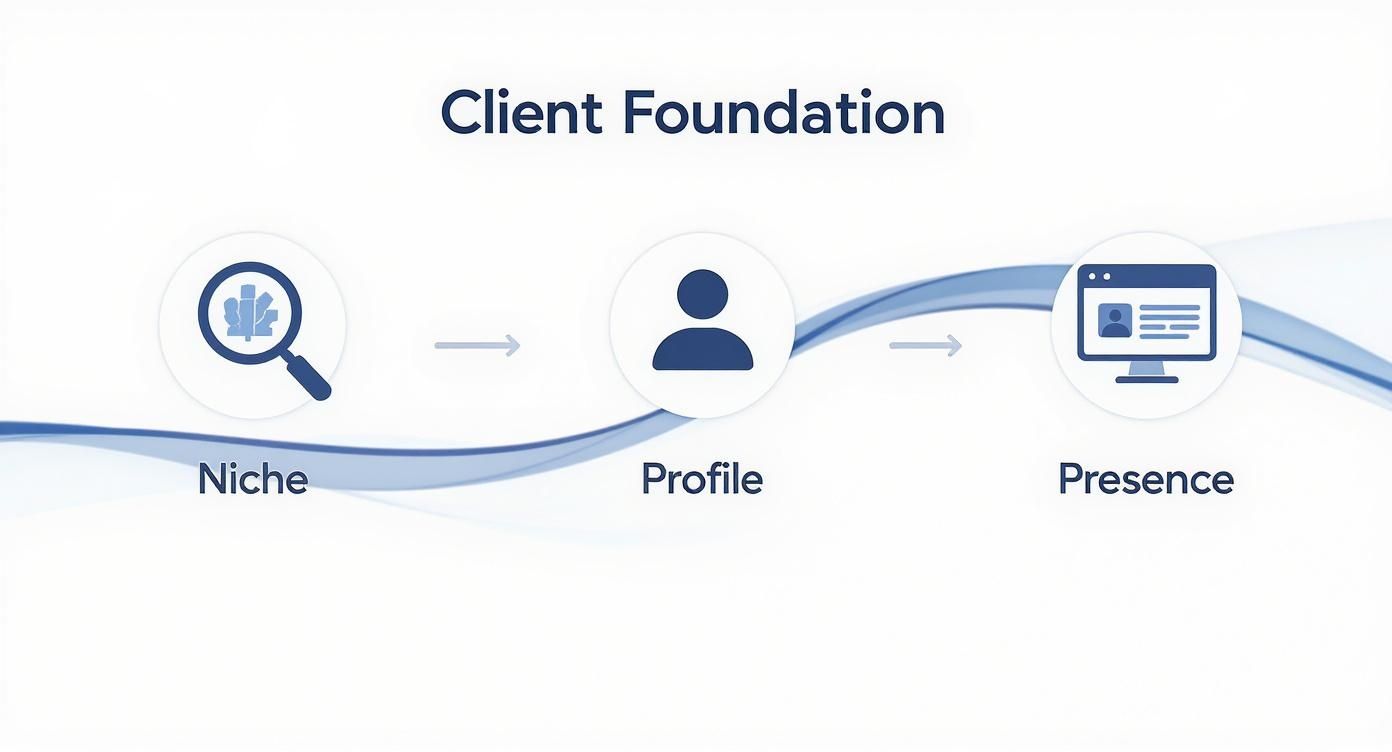
Get these pieces right, and you're already ahead of 90% of the competition.
Build Hyper-Targeted Lead Lists
Let’s be blunt: the success of any outbound campaign lives or dies by the quality of your lead list. A generic list is a one-way ticket to a 0% response rate and a ton of wasted time. Your real mission is to build a highly targeted list of decision-makers who are a perfect match for the Ideal Client Profile you already built.
This is where data platforms become your best friend. Tools like Apollo or PhantomBuster are absolute game-changers, letting you slice and dice huge databases with surgical precision.
You can zero in on prospects based on things like:
- Job Title: VPs of Marketing, Heads of Engineering, etc.
- Industry: B2B SaaS, DTC E-commerce, etc.
- Company Size: Number of employees or annual revenue.
- Technologies Used: Companies that use HubSpot, Shopify, etc.
- Buying Intent Signals: Companies actively hiring for a specific role or that just got funded.
This level of detail means every single person on your list is a high-potential fit. You're not guessing anymore; you're targeting people who have the exact problem you were born to solve.
Deploy Smart Cold Email Sequences
With your hit list ready, the next step is writing an email sequence that actually gets opened, read, and replied to. Those generic, "me-me-me" emails? Deleted in a nanosecond. Good cold emails are short, personalized, and focused entirely on the recipient's world.
A winning cold email usually has three core parts:
- A Personalized Opener: Reference a recent company milestone, a LinkedIn post they wrote, or a shared connection. Show them you’ve done at least 60 seconds of homework.
- A Clear Problem Statement: Briefly mention a common headache your ICP deals with—one you know how to fix.
- A Soft Call-to-Action (CTA): Ditch the pushy "Book a call" links. Instead, ask an interest-based question like, "Is this something on your radar for Q3?"
Remember, the goal of the first email isn’t to sell. It's just to start a conversation. You're fishing for a reply to see if there's a potential fit.
To run this playbook without losing your mind, an outreach platform like Lemlist is a must. It lets you automate a multi-step follow-up sequence. Since over 80% of deals require five or more follow-ups, automation makes sure you stay persistent without living in your inbox all day. For a much deeper tactical breakdown, check out our complete guide on how to get consulting clients with cold email.
Master LinkedIn Outreach That Builds Rapport
LinkedIn is an absolute goldmine for consultants, but most people use it all wrong. They fire off spammy, automated connection requests with a sales pitch baked in. That approach doesn't just fail; it actively destroys trust before you've even had a chance to build it.
A much better way? Prioritize genuine connection and build rapport before you even think about making an ask.
Start by engaging with your prospect's content. Don't just "like" their posts—leave insightful comments that add to the conversation. Share their articles with your network and add your own two cents. This gets you on their radar in a positive, value-first way.
After a few of these genuine interactions, send a personalized connection request that references your engagement. Once they accept, keep the conversation going in the DMs. Instead of pitching, ask smart questions about their work or a challenge they mentioned in a recent post.
This human-centered approach feels less like a sales pitch and more like a curious colleague reaching out. It dramatically increases your odds of starting a real dialogue that can actually lead somewhere.
Building an Inbound Marketing Engine
Outbound gets you meetings next week. An inbound marketing engine builds your legacy.
Think of it as a system that works for you 24/7, attracting your ideal clients even while you’re head-down on client work or—dare I say it—taking a vacation. It's about creating a library of assets that positions you as the undisputed expert in your niche.
When you nail this, the dynamic flips. You stop chasing leads and start attracting them—prospects who show up already convinced you're the one who can solve their problem. It’s a long game, for sure, but it's the single most powerful way to scale your consulting business.
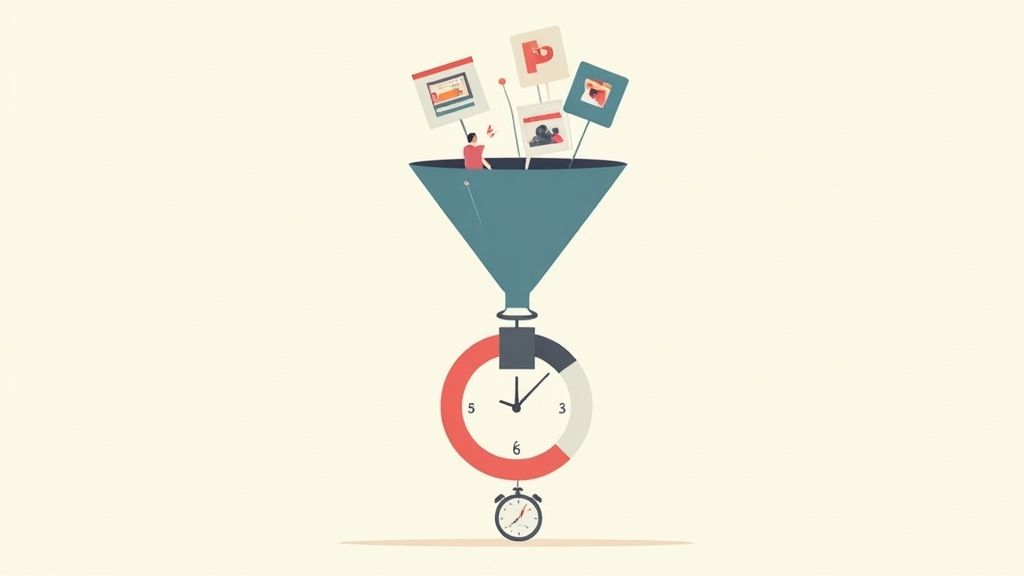
Uncover What Your Clients Are Searching For
The entire foundation of a winning inbound strategy is knowing exactly what questions your ideal clients are typing into Google. No guesswork allowed. You're using real data to find the specific pain points and queries that scream "I need help."
This process is called keyword research, and it’s non-negotiable. It’s the difference between publishing an article that gets found and one that collects digital dust. I use tools like Frase for this because they help me quickly spot high-potential keywords, see what's already ranking, and build content briefs that are engineered to win from the start.
Your goal is to find topics that hit the trifecta:
- High Relevance: Directly tied to the expensive, painful problems you solve.
- Reasonable Difficulty: Not trying to outrank HubSpot or Forbes for a generic term.
- Clear Intent: The searcher is looking for a solution, not just a quick definition.
Once you’ve got a solid list of these topics, you have a content roadmap. It’s a blueprint for everything you need to create to get clients coming to you. If you want a deeper dive on the mechanics, check out our guide on how to do search engine optimization yourself.
Create Authority-Building Content
With your keywords locked in, it's time to create genuinely helpful content that answers those questions better than anyone else on the internet. This is where you put your expertise on display and build trust at scale. A killer piece of content isn't just a blog post; it's a pillar asset you can milk for weeks.
Start by writing a comprehensive, "ultimate guide" style blog post that solves a specific problem from A to Z. Don't hold back. The more value you give away for free, the more clients will trust you enough to pay for your help with implementation.
Next, turn that written content into a video. This doesn't have to be a big production. Simple screen-share tutorials, talking-head explainers, or client case study breakdowns work wonders. Video is incredible for building a personal connection before you ever hop on a call.
The secret to great inbound content is simple: be relentlessly helpful. Answer the questions your clients have with so much clarity and depth that they see you as the only logical person to hire.
Repurpose and Distribute Your Assets
Creating one great piece of content is hard work. The smart move is to make that asset work as hard as possible for you. A single 2,000-word blog post or a 10-minute video can be atomized into dozens of smaller pieces for every channel that matters.
This is how you build omnipresence in your niche without completely burning out. I’ve started using an AI-powered tool called Opus Clips that takes a long-form video and automatically chops it into viral-style short clips—perfect for LinkedIn, YouTube Shorts, and TikTok. It’s a massive time-saver.
Here’s what a simple repurposing workflow looks like:
- Pillar Content: One long-form blog post.
- Video Version: Record a 10-15 minute YouTube video covering the same topic.
- Short Clips: Use Opus Clips to generate 5-7 short videos from the main one.
- LinkedIn Posts: Write 3-4 text and image posts pulling key takeaways from the blog.
- Email Newsletter: Send the full guide to your email list.
To manage all this without living on social media, plug everything into a scheduler like SocialBee. You can load up your content, set a schedule, and let the tool do the posting, ensuring you stay top-of-mind consistently.
While these digital strategies are incredibly powerful, never forget about your network. Referrals are still a massive engine for growth. In fact, research shows that around 60% of consultants land their first client through a referral, and more than half say referrals make up 60% of their total business. Nurturing those professional relationships is just as important as any content you'll ever create.
Crafting Proposals That Close Deals
You’ve done the hard work. All the outreach and content creation finally paid off, and you've got an interested prospect on the line. This is where potential turns into profit.
A well-crafted proposal isn't just a price list. Think of it as a strategic sales document. Its whole purpose is to bridge the gap between their problem and your solution, making your fee feel like an obvious, high-value investment.
Getting this right is what separates you from being just another consultant and elevates you to a trusted partner. This is your final pitch—the document that either lands the deal or leaves you wondering what went wrong. The goal isn't to list tasks; it's to paint a vivid picture of the future state you're going to help them achieve.
Choosing the Right Pricing Model
Before you can even start writing, you have to figure out how you're going to charge. Your pricing strategy is a massive lever that impacts your income, how clients perceive you, and the overall scope of your projects. Nailing this down is critical for building a sustainable business.
Most consultants lean on one of three core models:
- Hourly: Simple and direct. You bill for every hour you work. This is usually best for projects with a fuzzy, undefined scope or those that need ongoing, unpredictable support. The big downside? It punishes efficiency. The faster and better you get, the less you earn.
- Project-Based: This is my personal favorite for most engagements. You charge a flat fee for a clearly defined set of deliverables. It’s perfect for projects with a clear beginning and end because it aligns your incentives with the client's—everyone wants the outcome delivered efficiently. It does require you to get good at estimating your time, but it offers the highest profit potential by far.
- Retainer: The gold standard for predictable revenue. A client pays you a fixed monthly fee for ongoing access to your expertise. This is ideal for long-term strategic guidance, management, or support after an initial project is complete.
A lot of successful consultants, myself included, use a hybrid approach. You might kick things off with a project-based engagement to prove your value, then transition that happy client into a monthly retainer for ongoing work.
To help you decide, here’s a quick breakdown of how these models stack up against each other.
Consulting Pricing Model Comparison
This table gives you a comparative analysis of the most common consulting pricing models, designed to help you pick the best fit for your services and clients.
| Pricing Model | Best For | Pros | Cons |
|---|---|---|---|
| Hourly Rate | Projects with undefined scope, ongoing support, or when the client needs maximum flexibility. | Simple to understand and track. Guarantees payment for all time spent. Low risk for the consultant. | Penalizes efficiency. Clients may micromanage hours. Creates an unpredictable budget for the client. |
| Project-Based Fee | Clearly defined projects with specific deliverables and a fixed timeline (e.g., website redesign, SEO audit). | Value-based pricing allows for higher profit margins. Predictable costs for the client. Focus is on results, not hours. | Requires accurate scope and time estimation. Scope creep can kill profitability if not managed well. |
| Monthly Retainer | Long-term relationships requiring ongoing strategic advice, support, or management (e.g., content marketing, CRO). | Creates predictable, recurring revenue. Fosters deep client relationships. Allows for strategic, long-term impact. | Can be a harder initial sell. Requires consistent value delivery to justify the recurring fee. |
Ultimately, the best model depends on the project's nature and your client's needs. Don't be afraid to start with one and transition to another as the relationship evolves.
The Anatomy of a High-Converting Proposal
A proposal that actually wins deals doesn't just list what you'll do. It frames the client's problem, positions your solution as the only logical choice, and clearly spells out the return on their investment. It should read like a persuasive story, not a dry technical document.
A great proposal is less about your process and more about their outcome. Focus on the transformation you deliver, and the price becomes a secondary detail.
Keep your proposal clean, professional, and dead simple to navigate. Break it down into these key sections:
1. The Problem
Start by recapping the challenges and pain points you uncovered in your discovery call. Use their own words back to them. This instantly shows you were listening and that you get it.
2. The Proposed Solution
This is where you outline your strategic approach. Don't just give them a laundry list of tasks. Explain why your methodology is the best path forward to solve their specific problem and hit their goals. Connect your actions to their desired outcomes.
3. Deliverables & Timeline
Get crystal clear on what the client will receive and when they'll receive it. Use milestones to manage expectations and show a clear, logical path from start to finish. This builds confidence and reduces anxiety.
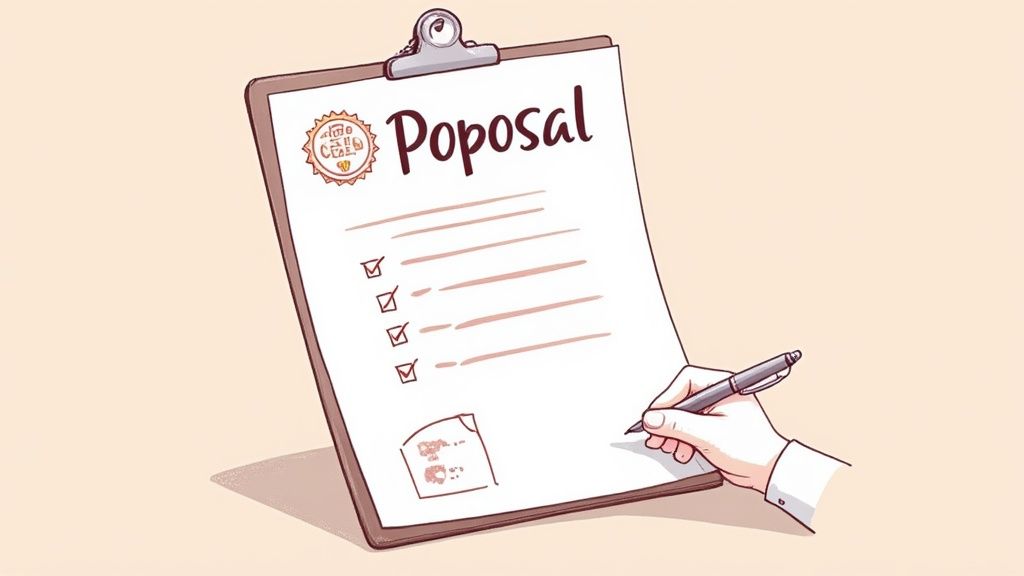
4. The Investment
Present your pricing clearly and confidently. Always frame it as an "investment," not a "cost." I highly recommend offering two to three package options (e.g., a "Core," "Growth," and "Scale" package). This gives the client a sense of control and anchors your preferred option against the others, making it seem like the best value.
5. Next Steps
Make it ridiculously easy for them to say "yes." Tell them exactly what to do next, whether it's signing the agreement, processing the initial payment, or scheduling the kickoff call.
Better yet, use an e-signature tool like Sign now to remove every bit of friction. It lets them approve the proposal and sign the contract with a single click. This one simple step can dramatically shorten your sales cycle and get projects started faster.
Delivering a World-Class Client Experience
Signing the contract isn't the finish line—it's the starting gun. Your proposal got you the "yes," but the actual client experience is what turns a one-off project into a long-term retainer and a steady stream of referrals. This is your most powerful marketing tool, and it kicks off the second they agree to work with you.
Getting this part right is how you stop the endless grind for new clients. A killer delivery process creates advocates who will happily do the selling for you. It's the engine that drives sustainable growth and builds a reputation that walks into the room before you do.
Nailing the Client Onboarding Process
A chaotic start plants seeds of doubt. A smooth, professional onboarding, on the other hand, immediately tells the client they made the right choice and builds a foundation of trust from day one. Your goal is to make them feel completely taken care of.
This isn't about setting up some ridiculously complicated workflow. It's about clarity, communication, and setting the right expectations right from the jump.
Here’s a simple checklist to create a seamless onboarding experience:
- Welcome & Logistics: As soon as that contract is signed, send a welcome email. Confirm you’ve received payment, clearly outline the next steps, and include a link to schedule the official kickoff call.
- Access & Assets: Be crystal clear about what you need from them—logins, documents, team contacts, you name it. Provide a secure, easy way for them to hand everything over.
- Kickoff Call Agenda: Send an agenda for the kickoff call at least 24 hours in advance. This is a small thing, but it shows you're organized and respect their time.
- Set Up a Shared Hub: Create one central place for all project communication and files. This simple step kills the endless email chains and keeps everyone on the same page.
A shared project space is non-negotiable for modern consultants. It acts as a single source of truth. A tool like Notion is perfect for creating a custom client portal, while something like Todoist is great for managing shared tasks and hitting deadlines.
Setting Expectations and Communication Cadence
Mismanaged expectations are the number one killer of client relationships. Period. The kickoff call is your prime opportunity to establish the rules of engagement, define what a "win" looks like, and agree on a communication rhythm that works for everyone.
Your job in the first call is to over-communicate. Leave no room for assumptions. Clearly define milestones, roles, and how and when you'll provide updates.
During this call, you absolutely must cover:
- Project Goals: Reiterate the main objectives and the key metrics you'll be tracking to measure success. Get them to nod along.
- Key Milestones: Walk them through the project timeline. Point out the major checkpoints and what deliverables they can expect at each stage.
- Communication Channels: Define where you'll talk. Is it Slack for quick chats? Your Notion hub for formal updates? Scheduled calls for reviews? Lock it in.
- Response Times: Set realistic expectations for how quickly you'll get back to them. Answering within 24 hours on weekdays is a solid standard.
This upfront clarity is your best defense against scope creep. It calms client anxiety and gets the project started on the right foot, positioning you as a strategic partner, not just a hired gun.
Proactive Updates and Flawless Delivery
Once the project is rolling, your goal is to be proactive, not reactive. Don't make your client chase you for an update. Send a quick weekly or bi-weekly progress report—even a short summary of what you did and what's next builds incredible confidence.
The way consultants deliver work is changing fast. To keep clients happy and attract new ones, you have to keep up. Many of us are now running virtual workshops, sharing real-time dashboards, and using AI-powered tools to manage projects. This shift has been great for solo consultants, leveling the playing field and letting us offer top-tier expertise without the overhead of in-person meetings.
The industry is moving away from purely custom, labor-heavy projects toward scalable, tech-assisted services that are more efficient. You can learn more about these consulting industry trends to stay ahead of the curve.
Master this delivery process, and your reputation for excellence becomes your best lead-generation asset. A happy client is the warmest lead you could ever ask for.
A Few Common Questions About Finding Your First Clients
As you get started, you're going to have questions. Everyone does. Here are some of the most common ones I hear from consultants, whether they're fresh out of the gate or have been at it for a while.
How Long Does It Really Take to Land That First Client?
This one depends almost entirely on your network and how specific your niche is.
If you’ve got a solid list of industry contacts from a past life, you could realistically land a referral client within 30 to 60 days of hanging your shingle. That's the best-case scenario.
But if you're building your business from the ground up with cold outreach and content, a more realistic timeline is 90 days of focused, consistent effort. The key word there is consistent. The more targeted your outreach is and the clearer your value prop, the faster things will start clicking.
What's the Single Most Effective Strategy for a New Consultant?
When you're new, you can't afford to put all your eggs in one basket. The winning formula is a one-two punch: warm outreach to your existing network combined with a highly targeted cold outbound campaign.
First, go through your contacts. Systematically let former colleagues, managers, and professional acquaintances know what you're doing and exactly who you help.
At the same time, fire up a focused outbound campaign. This could be on LinkedIn or through cold email using a tool like Apollo. This dual-pronged approach gives you the best shot at some early wins while you build out a more sustainable, long-term pipeline.
Don't get stuck waiting for the "perfect" moment to start. Action creates clarity. A focused hour of outreach every single day is way more effective than a full day of activity once a week. Consistency is what separates the consultants who make it from those who stay stuck in the "planning" phase.
How Much Content Do I Need to Create for Inbound Leads?
When it comes to content, think quality, not quantity. Your goal should be to publish one incredibly valuable piece of content per week. I'm talking about a comprehensive blog post that solves a very specific, expensive problem for your ideal client.
From that one "pillar" piece, you can easily slice and dice it into 3-5 smaller social media posts to share throughout the week. Be warned, though: inbound is a long game. It can easily take 3-6 months of this weekly rhythm before you see any significant results. To make sure your hard work actually gets found, using an SEO tool like Frase is non-negotiable.
Should I Work for Free Just to Get My First Client?
I get why people ask this, but working for free is a dangerous trap. It devalues your expertise right from the start and sets a bad precedent.
A much smarter move is to offer a "founding client" discount to your first one to three clients. This strategy helps you build up those all-important case studies and testimonials while still getting paid for your work.
Frame it as a limited-time offer. You give them a great rate, and in exchange, they give you honest feedback and a killer testimonial when the project wraps. But here's the critical part: always use a formal contract, even for discounted work. A tool like Deel or Airslate can help you create professional agreements that protect both you and your brand-new client.
